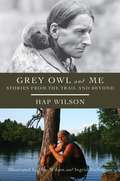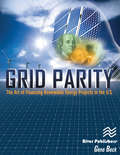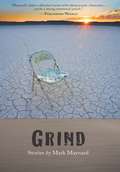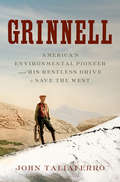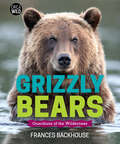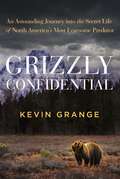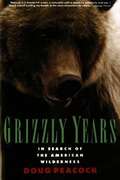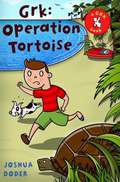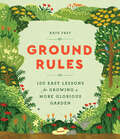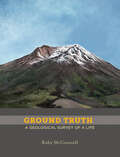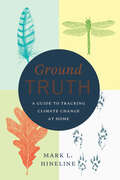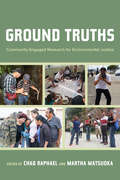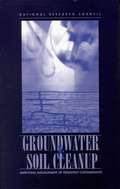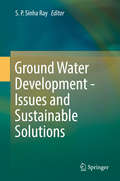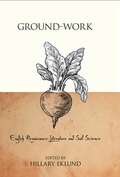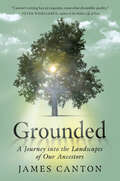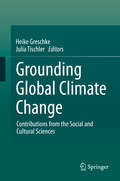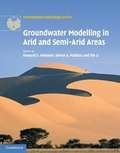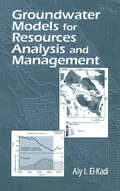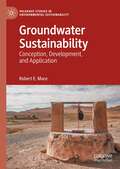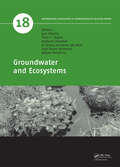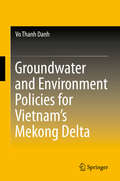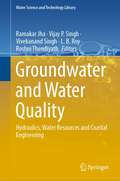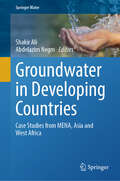- Table View
- List View
Grey Owl and Me: Stories From the Trail and Beyond
by Hap Wilson Ingrid ZschognerHap Wilson is back for another journey, this time on the lighter side of the adventure trail, where the bizarre melds with the sublime. Nurtured by the writings of Canadian environmentalist and wannabe-Native, Grey Owl, Wilson adopted a lifestyle similar to the 1930s conservationist but with his own twists and turns along a meandering path full of humorous misadventures. Wilson, too, learned many of his nature skills as a youth, paddling in Temagami, working as a wilderness canoe ranger and guide, and following in the footsteps of one of Canada’s most revered outdoor icons. The author recounts early days winter camping, motorcycling the Labrador coast, and teaching actor Pierce Brosnan how to throw knives and paddle a canoe for the Richard Attenborough film about Grey Owl. He also takes us to a few of his favourite places and shares intimate secrets of wilderness living. Here, Grey Owl has returned as an ever-present critic – a buckskin-clad spectre in a modern world of Gore-Tex, Kevlar canoes, and gear freaks.
Grid Parity: The Art of Financing Renewable Energy Projects in the U.S.
by CLP Beck CEMGrid Parity provides an in-depth examination of the knowledge, insights, and techniques that are essential to success in financing renewable energy projects. An energy project finance expert with 35 years of experience in capital asset financing, the author provides a comprehensive overview of how to finance renewable energy projects in America today. He explores all components of "the deal" including tax, accounting, legal, regulatory, documentation, asset management and legislative drivers to this dynamic growth sector. Filled with case studies, the book provides a thorough examination of what it takes to compete in the green-energy marketplace.
Grind
by Mark MaynardConvicts round up wild mustangs, a schizophrenic homeless man wins the jackpot and disappears, a truck driver with a child's mind spends his last hours in the embrace of a prostitute's photos-disparate and vivid, Mark Maynard's characters intersect in the new wild west of Reno, Nevada."Throughout the volume's eight tenuously linked tales, lives and fortune are lost, and the city of Reno emerges as a locus of shattered souls. Maynard's debut collection bursts with idiosyncratic characters...packs a strong emotional punch...is strangely entertaining."-Publishers Weekly"In Grind, Maynard reveals a world the Nevada tourism board would rather you didn't see...A debut collection of stories that perfectly captures the seediness, desperation and sense of loss permeating the hot desert world of Reno."-Shelf Awareness"Mark Maynard's Reno is so sleazily appealing, so filled with convict cowboys, wild horses, racing pilots, truckers, snow bums, eco-terrorists, tattoo conventions, pawnshops and jackpots that you emerge from reading Grind dazed by this author's empathy for neglected quarters of humanity. You feel gritty all over-and more alive."-Carolyn Cooke, author of Daughters of the Revolution"The characters in these stories are as beautiful and broken as the desert itself. Mark Maynard explores the stony truths of lost lives with an unflinching eye for detail, an insider's sense of the place and its people, and an honest compassion. The heartbreaks here are real, as are the moments of uncommon grace and hard-won redemption."-Kim Barnes, author of In the Kingdom of Men"Mark Maynard's Grind is chock full of men and women who are desperate with want and full of spirit. Pawnbrokers. Truckers. Casino shills. Prison inmates. They're all here, and they're all gloriously alive. This is prime American fiction-tough, generous, and open-eyed."-Alyson Hagy, author of Boleto"Grind is exactly what I like in a locally based book. Plenty of those characters who make a visit to the environs of Reno both an exciting potential and an illicit affair...This is a Northern Nevada book."-D. Brian Burghart, Reno News & Review
Grinnell: America's Environmental Pioneer And His Restless Drive To Save The West
by John TaliaferroBefore Rachel Carson, there was George Bird Grinnell—the man whose prophetic vision did nothing less than launch American conservation. George Bird Grinnell, the son of a New York merchant, saw a different future for a nation in the thrall of the Industrial Age. With railroads scarring virgin lands and the formerly vast buffalo herds decimated, the country faced a crossroads: Could it pursue Manifest Destiny without destroying its natural bounty and beauty? The alarm that Grinnell sounded would spark America’s conservation movement. Yet today his name has been forgotten—an omission that John Taliaferro’s commanding biography now sets right with historical care and narrative flair. Grinnell was born in Brooklyn in 1849 and grew up on the estate of ornithologist John James Audubon. Upon graduation from Yale, he dug for dinosaurs on the Great Plains with eminent paleontologist Othniel C. Marsh—an expedition that fanned his romantic notion of wilderness and taught him a graphic lesson in evolution and extinction. Soon he joined George A. Custer in the Black Hills, helped to map Yellowstone, and scaled the peaks and glaciers that, through his labors, would become Glacier National Park. Along the way, he became one of America’s most respected ethnologists; seasons spent among the Plains Indians produced numerous articles and books, including his tour de force, The Cheyenne Indians: Their History and Ways of Life. More than a chronicler of natural history and indigenous culture, Grinnell became their tenacious advocate. He turned the sportsmen’s journal Forest and Stream into a bully pulpit for wildlife protection, forest reserves, and national parks. In 1886, his distress over the loss of bird species prompted him to found the first Audubon Society. Next, he and Theodore Roosevelt founded the Boone and Crockett Club to promote “fair chase” of big game. His influence among the rich and the patrician provided leverage for the first federal legislation to protect migratory birds—a precedent that ultimately paved the way for the Endangered Species Act. And in an era when too many white Americans regarded Native Americans as backwards, Grinnell’s cries for reform carried from the reservation, through the halls of Congress, all the way to the White House. Drawing on forty thousand pages of Grinnell’s correspondence and dozens of his diaries, Taliaferro reveals a man whose deeds and high-mindedness earned him a lustrous peerage, from presidents to chiefs, Audubon to Aldo Leopold, John Muir to Gifford Pinchot, Edward S. Curtis to Edward H. Harriman. Throughout his long life, Grinnell was bound by family and sustained by intimate friendships, toggling between the East and the West. As Taliaferro’s enthralling portrait demonstrates, it was this tension that wound Grinnell’s nearly inexhaustible spring and honed his vision—a vision that still guides the imperiled future of our national treasures.
Grizzly Bears: Guardians of the Wilderness (Orca Wild #10)
by Frances BackhouseGrizzlies are one of North America’s most iconic wildlife species. They once roamed across half the continent, but today the grizzly population has declined at an alarming rate and it is incredibly difficult to rebuild those numbers, especially in places with a lot of people. Yet grizzlies are key members of their ecological communities and a powerful symbol of wilderness. Filled with facts and richly illustrated with photos, Grizzly Bears: Guardians of the Wilderness explores the biology of grizzlies and the vital ecological role these bears play, and it asks readers to consider what it takes to share the land with them. Learn from conservationists, scientists, Indigenous Peoples and young people who are working to ensure that grizzlies will be with us forever.
Grizzly Confidential: An Astounding Journey into the Secret Life of North America’s Most Fearsome Predator
by Kevin GrangeIn?Grizzly Confidential, author Kevin Grange—former paramedic and park ranger at Yellowstone and Grand Teton—comes face-to-face with North America&’s most fearsome predator, Ursus Arctos. His quest takes him from his home in the Tetons to an eerie, mist-shrouded island of gigantic bruins; from the Bear Center at Washington State University—where scientists believe the secrets of hibernation might help treat diabetes, heart disease, and obesity in humans—to the dark underbelly of for-profit wildlife parks, illegal animal trade and black markets hawking bear bile.Along the way, he meets fascinating biologists and activists and discovers that everything he knew about grizzlies was wrong. Ultimately, his odyssey leads him to find answers on a remote corner of the Alaskan Peninsula where, for the last fifty years, humans have coexisted peacefully alongside the largest gathering of brown bears on the planet.?? ??Grizzly Confidential is about bears but also the inspiring people who look after them. This is a fast-paced, gripping story that educates, entertains, and gives a sneak peek into the secret life of a well-known species. Part science, part travelogue, and a passionate plea for bear conservation, Grizzly Confidential is a lively account for anyone who loves the outdoors and learning about the natural world.?
Grizzly Years: In Search of the American Wilderness
by Doug PeacockFor nearly twenty years, alone and unarmed, author Doug Peacock traversed the rugged mountains of Montana and Wyoming tracking the magnificent grizzly. His thrilling narrative takes us into the bear's habitat, where we observe directly this majestic animal's behavior, from hunting strategies, mating patterns, and denning habits to social hierarchy and methods of communication. As Peacock tracks the bears, his story turns into a thrilling narrative about the breaking down of suspicion between man and beast in the wild.
Grk: Operation Tortoise
by Joshua DoderWhile vacationing in the Seychelles, Tim discovers a well-guarded private island where he learns of a devious plot that threatens the endangered local giant tortoise.
Ground Rules: 100 Easy Lessons for Growing a More Glorious Garden
by Kate Frey100 rules to garden by Gardening doesn’t have to be difficult, and Kate Frey—expert gardener and designer—makes it easier than ever with her new book, Ground Rules. Frey distills the vital lessons of gardening into 100 simple rules that will yield a gorgeous, healthy, and thriving home garden. Discover tips on garden design, care and maintenance, healthy soil, and the best ways to water. You’ll also learn how to create a garden that encourages birds and butterflies, how to choose healthy plants at the garden center, how and when to re-pot a container, and much more. With bite-size chunks of expert information and inspiring photographs, Ground Rules is your new go-to resource.
Ground Truth: A Geological Survey of a Life
by Ruby McConnell Jenny Kimura Amy RuppelFINALIST for the 2021 Oregon Book Award. Rooted in the Pacific Northwest, the essays in Ruby McConnell's Ground Truth: A Geological Survey of a Life cover the vast terrain of this region – from volcanoes to city parks, the eroding shorelines along the Oregon coast, badlands, lush forests, and city parks. Combining her background as a registered geologist, McConnell's essays also weave in personal landscapes composed of grief, loss, and optimism for the future of our environment. "The Pacific Northwest that you see today is the result of forty years of radical changes in the culture and economics of what was once a resource-extraction and agriculture-driven region. They are changes so fundamental in nature and scope...that, for those of us from this place, will always be marked by the cataclysmic eruptions of Mt. St. Helens on May 18, 1980." --Ruby McConnell In this collection of 17 essays, geologist Ruby McConnell opens her part natural history, part memoir-in-essays about the Pacific Northwest with the cataclysmic eruption of Mt. St. Helens in May of 1980. She was two years old. "Everything that I have stood direct witness to since, everything I know about this place, happe
Ground Truth: A Guide to Tracking Climate Change at Home
by Mark L. Hineline“Expertly crafted and enjoyable . . . transforms the complicated topics of phenology and climate change. . . . accessible, tangible, and actionable.” —Mark D. Schwartz, editor of Phenology: An Integrative Environmental ScienceBefore you read this book, grab a notebook, go outside, and find a nearby patch of nature. What do you see, hear, feel, and smell? Are there bugs, birds, squirrels, deer, lizards, frogs, or fish, and what are they doing? What plants are in the vicinity, and in what ways are they growing? What shape are the rocks, what texture is the dirt, and what color are the bodies of water? Everything you notice, write it all down.We know that the Earth’s climate is changing, and that the magnitude of this change is colossal. At the same time, the world outside is still a natural world, and one we can experience on a granular level every day.Featuring detailed guidance for keeping records of the plants, invertebrates, amphibians, birds, and mammals in your neighborhood, this book also ponders the value of everyday observations, probes the connections between seasons and climate change, and traces the history of phenology—the study and timing of natural events—and the uses to which it can be put.An expansive yet accessible book, Ground Truth is a guide to paying attention instead of turning away, and to gathering facts from which a fuller understanding of the natural world can emerge.“A unique DIY manual for becoming attuned to the rhythms of the natural world.” —James T. Costa, author of Darwin’s Backyard: How Small Experiments Led to a Big Theory“A necessary book.” —Susan J. Tweit, author of Walking Nature Home: A Life’s Journey
Ground Truths: Community-Engaged Research for Environmental Justice
by Chad Raphael and Martha MatsuokaA free ebook version of this title is available through Luminos, University of California Press’s Open Access publishing program. Visit www.luminosoa.org to learn more. This is the first book devoted entirely to summarizing the body of community-engaged research on environmental justice, how we can conduct more of it, and how we can do it better. It shows how community-engaged research makes unique contributions to environmental justice for Black, Indigenous, people of color, and low-income communities by centering local knowledge, building truth from the ground up, producing actionable data that can influence decisions, and transforming researchers’ relationships to communities for equity and mutual benefit. The book offers a critical synthesis of relevant research in many fields, outlines the main steps in conducting community-engaged research, evaluates the major research methods used, suggests new directions, and addresses overcoming institutional barriers to scholarship in academia. The coauthors employ an original framework that shows how community-engaged research and environmental justice align, which links research on the many topics treated in the chapters—from public health, urban planning, and conservation to law and policy, community economic development, and food justice and sovereignty.
Ground Water & Soil Cleanup: Improving Management of Persistent Contaminants
by National Research CouncilThis book presents a comprehensive, up-to-date review of technologies for cleaning up contaminants in groundwater and soil. It provides a special focus on three classes of contaminants that have proven very difficult to treat once released to the subsurface: metals, radionuclides, and dense nonaqueous-phase liquids such as chlorinated solvents.Groundwater and Soil Cleanup was commissioned by the Department of Energy (DOE) as part of its program to clean up contamination in the nuclear weapons production complex. In addition to a review of remediation technologies, the book describes new trends in regulation of contaminated sites and assesses DOE's program for developing new subsurface cleanup technologies.
Ground Water Development - Issues and Sustainable Solutions
by S. P. RayGround water resources are receiving global attention, as human population growth and development cause significant changes to the earth system. It plays a major role in ensuring livelihood security in many parts of South Asia and its contribution to poverty alleviation is substantial. The complex nature of ground water problems in the Indian Sub-continent requires a precise delineation of the ground water regimes in different hydro geological settings and socio-economic conditions and is a primary necessity for sustainable and equitable management. Strategies to respond to ground water over-exploitation and deteriorating water quality must be based on a new approach. Practical policies and various solution options urgently need to be formulated and implemented to prevent the development problems. There is pressing need to evolve workable methods and approaches based on modern scientific researches on ground water resources, as well as to build a social framework including community participation at all levels for a ground water development system. The community participation in water pumping policies, incentives of efficient use, affordability of low income users and other vulnerable groups, water awareness are prime factors for success of any ground water based water supply project.
Ground-Work: English Renaissance Literature and Soil Science (Medieval & Renaissance Literary Studies)
by Hillary EklundHow does soil, as an ecological element, shape culture? With the sixteenth-century shift in England from an agrarian economy to a trade economy, what changes do we see in representations of soil as reflected in the language and stories during that time? This collection brings focused scholarly attention to conceptions of soil in the early modern period, both as a symbol and as a feature of the physical world, aiming to correct faulty assumptions that cloud our understanding of early modern ecological thought: that natural resources were then poorly understood and recklessly managed, and that cultural practices developed in an adversarial relationship with natural processes. Moreover, these essays elucidate the links between humans and the lands they inhabit, both then and now.
Ground-Work: English Renaissance Literature and Soil Science (Medieval & Renaissance Literary Studies)
by Hillary EklundHow does soil, as an ecological element, shape culture? With the sixteenth-century shift in England from an agrarian economy to a trade economy, what changes do we see in representations of soil as reflected in the language and stories during that time? This collection brings focused scholarly attention to conceptions of soil in the early modern period, both as a symbol and as a feature of the physical world, aiming to correct faulty assumptions that cloud our understanding of early modern ecological thought: that natural resources were then poorly understood and recklessly managed, and that cultural practices developed in an adversarial relationship with natural processes. Moreover, these essays elucidate the links between humans and the lands they inhabit, both then and now.
Grounded: A Journey into the Landscapes of Our Ancestors
by James CantonFrom the author of The Oak Papers comes a beautiful meditation on how to foster a profound and healing spiritual communion with the natural world, exploring how the sacred can be accessed by looking to the past, to our ancestors and how they tread through their worlds.“Canton's writing has an exquisite, somewhat dreamlike quality.”—Peter Wohlleben, author of The Hidden Life of TreesWhen James Canton walked into Suffolk’s Lindsey Chapel, it was the beginning of what would become a new journey in his life—hours away from the bustling city of London and distant from the years in his early twenties when he traveled from Egypt to Argentina. Standing inside the quaint chapel, Canton realized that his past cosmopolitan desires had been replaced by an intense yearning to understand the history of the place he called home, a burning curiosity about the past and the spiritual ways and beliefs of the people who came before us.In Grounded, Canton retraces his steps into the places where our ancestors have experienced profound emotion, otherwise known as numinous experiences, to help us better understand who we are. Through lyrical meditation, reflection, and a thoughtful consideration of the ways and beliefs of the people who came before us, Canton seeks to know what our ancestors considered to be human, and what lessons we can learn from them to find security in our contemporary selves. Steeped in literary and folklore references, Grounded is a powerful exploration of the power of nature to soothe, nourish, and inspire the human soul.
Grounding Global Climate Change
by Heike Greschke Julia TischlerThis book traces the evolution of climate change research, which, long dominated by the natural sciences, now sees greater involvement with disciplines studying the socio-cultural implications of change. In their introduction, the editors chart the changing role of the social and cultural sciences, delineating three strands of research: socio-critical approaches which connect climate change to a call for cultural or systemic change; a mitigation and adaption strand which takes the physical reality of climate change as a starting point, and focuses on the concerns of climate change-affected communities and their participation in political action; and finally, culture-sensitive research which places emphasis on indigenous peoples, who contribute the least to the causes of climate change, who are affected most by its consequences, and who have the least leverage to influence a solution. Part I of the book explores interdisciplinarity, climate research and the role of the social sciences, including the concept of ecological novelty, an assessment of progress since the first Rio climate conference, and a 'global village' case study from Portugal. Part II surveys ethnographic perspectives in the search for social facts of global climate change, including climate and mobility in the West African Sahel, and human-non human interactions and climate change in the Canadian Subarctic. Part III shows how collaborative and comparative ethnographies can spin "global webs of local knowledge," describing case studies of changing seasonality in Labrador and of rising water levels in the Chesapeake Bay. These perspectives are subjected to often-amusing, always incisive analysis in a concluding chapter entitled "You Ain't Seen Nothing Yet: a death-defying look at the future of the climate debate. " The contributors engage critically with the research subject of 'climate change' itself, reflecting on their own practices of knowledge production and epistemological presuppositions. Finely detailed and sympathetic to a broad range of viewpoints, the book sets out a profile for the social sciences and humanities in the climate change field by systematically exploring methodological and theoretical challenges and approaches.
Groundwater Modelling in Arid and Semi-Arid Areas
by Howard S. Wheater Simon A. Mathias Xin LiArid and semi-arid regions face major challenges in the management of scarce freshwater resources under pressures of population, economic development, climate change, pollution and over-abstraction. Groundwater is commonly the most important water resource in these areas. Groundwater models are widely used globally to understand groundwater systems and to guide decisions on management. However, the hydrology of arid and semi-arid areas is very different from that of humid regions, and there is little guidance on the special challenges of groundwater modelling for these areas. This book brings together the experience of internationally-leading experts to fill a gap in the scientific and technical literature. It introduces state-of-the-art methods for modelling groundwater resources, illustrated with a wide-ranging set of illustrative examples from around the world. The book is valuable for researchers, practitioners in developed and developing countries, and graduate students in hydrology, hydrogeology, water resources management, environmental engineering and geography.
Groundwater Models for Resources Analysis and Management
by Aly I. El-KadiWritten by renowned experts in the field, this book assesses the status of groundwater models and defines models and modeling needs in the 21st century. It reviews the state of the art in model development and application in regional groundwater management, unsaturated flow/multiphase flow and transport, island modeling, biological and virus transport, and fracture flow. Both deterministic and stochastic aspects of unsaturated flow and transport are covered. The book also introduces a unique assessment of models as analysis and management tools for groundwater resources. Topics covered include model vs. data uncertainty, accuracy of the dispersion/convection equation, protocols for model testing and validation, post-audit studies, and applying models to karst aquifers.
Groundwater Sustainability: Conception, Development, and Application (Palgrave Studies in Environmental Sustainability)
by Robert E. MaceThis book will provide a comprehensive discussion of groundwater sustainability, including what it is, how its definition has changed over time, why traditional assessments of it are wrong, how assessments of it are ideally multidisciplinary efforts recognizing that policy is more controlling of outcomes than science, and why achieving it is difficult once pumping exceeds sustainable levels of pumping. The book will provide a nontechnical background of hydrogeology relevant to groundwater sustainability and present several case studies from around the United States and the world. The book has been designed to appeal to academics, students, and practitioners. Academics, particularly those just getting into the subject, will find the book a useful entry in terms of management concepts and political realities of attempting to achieve groundwater sustainability. It will also be useful to academics in that the book will include discussions on the history and development of groundwater sustainability and the practical aspects of aspiring to and achieving sustainable production. Although not a textbook, the book could be used as the basis for teaching a course or as a supplement to a hydrogeology or groundwater management class. Accordingly, the book will include questions and additional reading materials at the end of each chapter. This book will also be useful to practitioners through non-technical explanations of the sciences, discussions of the nuances of defining sustainability in aquifers, and the presentation of case studies where sustainable management has failed and succeeded.
Groundwater and Ecosystems
by António Chambel Luís Ribeiro Tibor Y. Stigter M. Teresa Condesso de Melo José Paulo Monteiro Albino MedeirosGroundwater resources are facing increasing pressure from consuming and contaminating activities. There is a growing awareness that the quantitative and qualitative preservation of groundwater resources is a global need, not only to safeguard their future use for public supply and irrigation, but also to protect those ecosystems that depend partial
Groundwater and Environment Policies for Vietnam’s Mekong Delta
by Vo Thanh DanhThis book provides an in-depth analysis of groundwater uses and environmental issues in the Mekong Delta. It focuses on groundwater pollution and use, urban flooding, living with flood policy, and climate change-related adaptation measures. The Mekong Delta is facing these serious issues in the course of its development.This book uses economic analysis methods such as risk cost benefit analysis, cost effectiveness analysis, contingent valuation method, economic loss valuation, and multi criteria analysis to provide policy makers and researchers a better understanding of issues faced by sea level rise-impacted regions around the world and provide possible solutions. Students of environmental economics, economic valuation, and public policy can use this work to enhance their analytical skills.
Groundwater and Water Quality: Hydraulics, Water Resources and Coastal Engineering (Water Science and Technology Library #119)
by Vijay P. Singh Ramakar Jha Vivekanand Singh L. B. Roy Roshni ThendiyathThis book deals with topics of current interest, such as climate change, floods, drought, and hydrological extremes. The impact of climate change on water resources is drawing worldwide attention these days, for water resources in many countries are already stressed and climate change along with burgeoning population, rising standard of living, and increasing demand are adding to the stress. Further, river basins are becoming less resilient to climatic vagaries. Fundamental to addressing these issues is hydrological modelling which is covered in these books. Further, integrated water resources management is vital to ensure water and food security. Integral to the management is groundwater and solute transport. The books encompass tools that will be useful to mitigate the adverse consequences of natural disasters. This book provides many new and innovative methods to assess groundwater and estimate water pollution. Groundwater recharge, solute transport, ground water modelling are some of the important variable used to estimate the groundwater movement, hydraulic gradient and pollution movement. The water quality is another important variable of river Ganga and its tributaries in India and other rivers over the globe.
Groundwater in Developing Countries: Case Studies from MENA, Asia and West Africa (Springer Water)
by Abdelazim Negm Shakir AliThis book comprehensively discusses different scientific approaches, including groundwater sustainability, numerical modeling, index approach, isotope hydrology, environmental Isotopes, and advanced GRACE satellite data from different regions in developing countries globally, to help understand the groundwater system for strategic management of freshwater resources. This would help estimate an accepted logistic framework that might help control, and evaluate the significance of predicted climatic and anthropogenic impacts on groundwater resources. The book presents and discusses unique case studies from Asia (Turkey, Afghanistan, and Kyrgyzstan), MENA (Middle East and North Africa), particularly focussing on Algeria, Egypt New Delta, and KSA and West Africa (Nigeria) and has chapters covering most of the other MENA countries. The book presents a comprehensive investigation of the methods employed for groundwater utilization, with a dual focus on elucidating existing issues and confronting contemporary challenges. The findings are significant as they provide a deeper understanding of the complex issues surrounding groundwater utilization. Approaches for enhancing and rationalizing water extraction from Saharan aquifers are discussed to promote regional advancement and preserve long-term sustainability. The book will be of great help to numerous researchers and academicians, and will be an important account for stakeholders.
